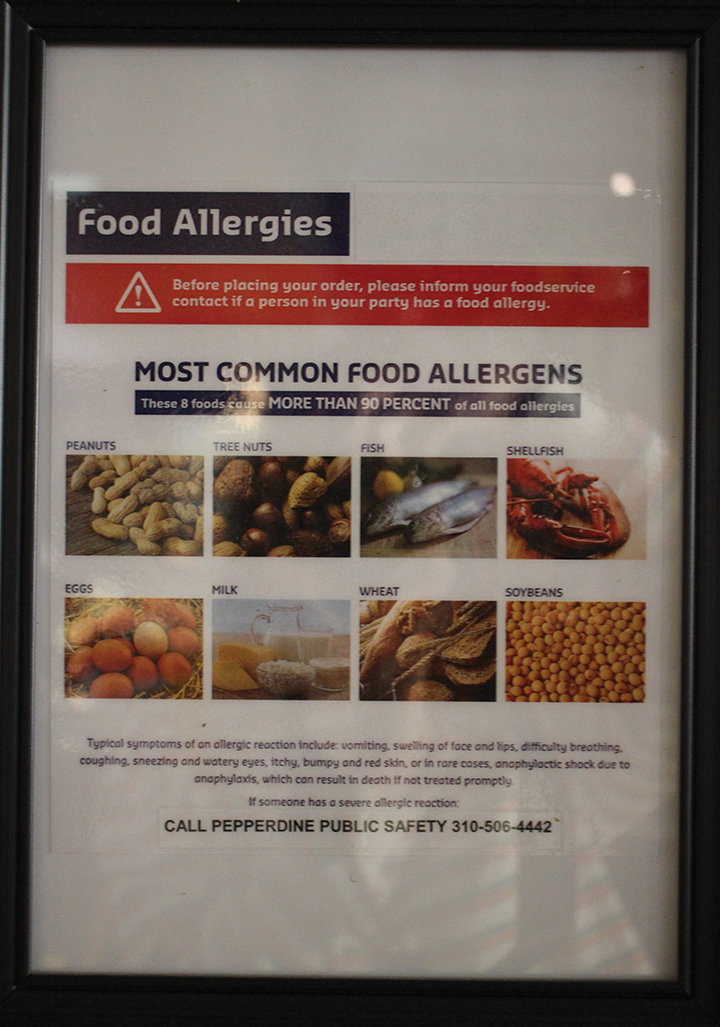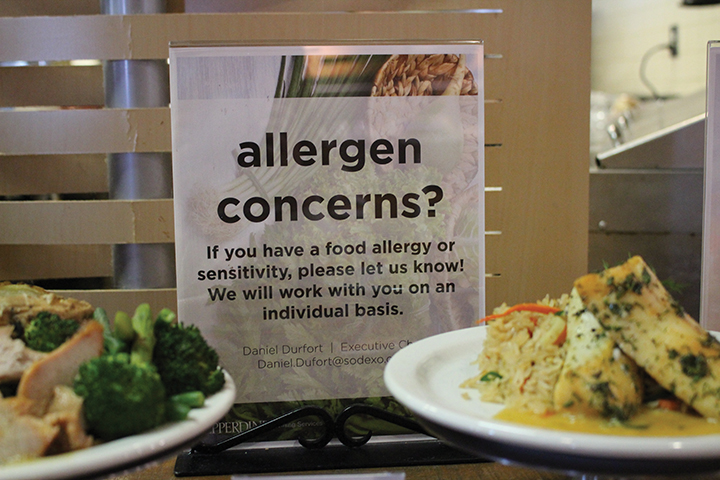Photos by Susannah Gallup
Midway through the spring 2019 semester, Waves Cafe posted a new sign at its entrance that informed students that all food prepared in its kitchen could have touched nuts, among other common allergens. Students said they were concerned for students with allergies, as the Waves Cafe is the only cafeteria on the Seaver Campus.

Photos by Susannah Gallup
Freshman Alexa Borstad said she has a severe peanut allergy.
Borstad wrote in an email that before the signs went up, she trusted that the food she was eating did not have any traces of peanuts.
“I simply thought that the food company, and the university, would be as careful as possible with nut allergies, considering this is our only true dining option on campus,” Borstad wrote.
The Dining Services Team started discussing the possibility of a sign about a month and a half ago, Director of Operations Elizabeth Nepute said.
“We are just trying to evolve,” Nepute said. “We are just trying to create a platform so people can get information.”
Before the signs were posted, Nepute said students would read the description of a dish and then ask the chef about its ingredients. Although this was effective, Nepute said by putting up the signs, the Dining Team is making it known that food could have allergens in it.
“Everything is produced in one kitchen,” Nepute said. “Things can be exposed. We can’t be 100 percent certain.”
Resident District Manager Rodney Reed said Dining Services wants to give “as much information as we can provide so [students] can make the best decision for themselves.”
Reed admitted that “allergies are pretty serious,” a sentiment that Nepute echoed.
Reed also said the sign is a precaution that is beneficial to the students and staff.
Having a sign in place allows the Waves Café to be held accountable for its cleanliness, because the Dining Team is “striving to make sure that we have sanitation practices in place,” Reed said.
The sign also removes the language barrier and benefits students who are shy because they are no longer dependent on asking the chefs about the ingredients, Reed said.

Photos by Susannah Gallup
Sous Chef Felix Fuentes said his approach to preparing meals for students with nut allergies has not changed that drastically since the signs went up.”Years ago,” Fuentes said there were “special meals” made away from the food that contained nuts, but now there are not options made only for people with nut allergies.
In the past two years, Fuentes said he started removing some of the meals and separating it before the nuts were added and has continued doing this after the signs were posted.
Reed said this tactic “allows our team to develop personal relationships with the people with allerg[ies].”
Fuentes said he has gotten to know all of the students with nut allergies. He said there were about 10 people in the last two years with major allergies.
Some people will double check with the chef on duty, and others will notify the Dining Team of their allergy and talk with them about their options, Nepute said. She said they have not gotten any complaints about the signs and people have appreciated them.
“It’s not meant to scare anybody,” Nepute said. “It’s just meant to inform people. We’re trying to avoid people being misinformed and give the most information.”
These signs directly affected all students with nut allergies, but their responses were varied.
Freshman Haley Brouwer, who has a peanut allergy, wrote in an email that before the signs, she would use common sense when eating at the Waves Café.
“I know the kinds of foods that have nuts in them, and so I could usually tell, and I would also avoid any foods that I thought might have them,” Brouwer wrote.
Brouwer wrote that “not much has changed” since the signs went up, but that is only because eating at the Waves Café was not that big of an issue for her before.
“I think the signs are helpful, even if it’s just for clarification or reassurance,” Brouwer wrote.
Borstad wrote that because her allergy is very severe, it has increased over the past last two years due to exposure to traces of peanuts.
Now that the signs are up, Borstad wrote that “[she is] hesitant to eat in the cafeteria,” and has been forced to buy groceries or eat off-campus. Nepute said there are other options for people with severe allergies, but Borstad said that she finds herself eating Starbucks when she needs to eat on-campus because it is a brand she can trust.
“I’m scared that I could have come in contact with trace amounts [of] peanuts in the past, which can worsen my body’s reaction to it in the future,” Borstad wrote.
Nepute said that the Dining Team has not received any complaints, but Borstad wrote that her response is mixed.
“I feel like the signs are helpful, but it is disheartening to see them now,” Borstad wrote. “I could only imagine the risk that certain students with severe allergies could have faced.”
________________________
Follow Rowan Toke on Twitter: @RowanToke
